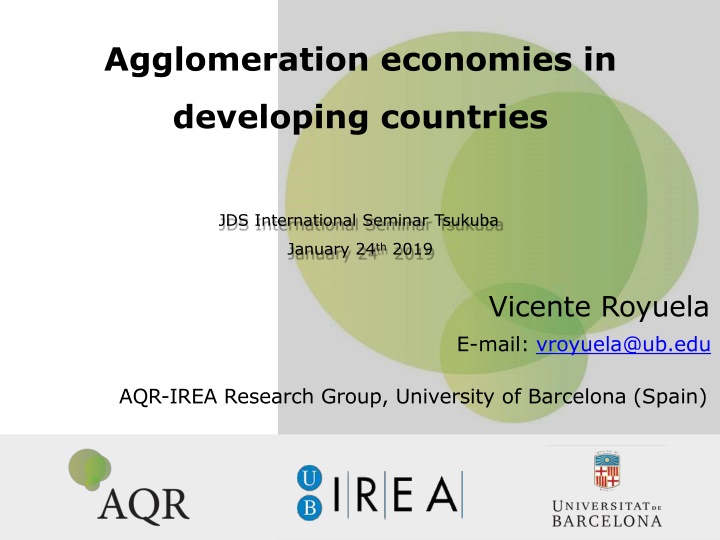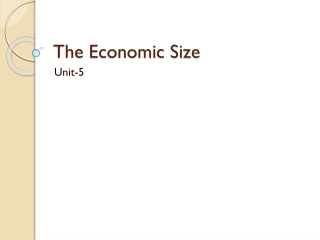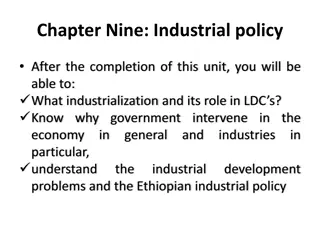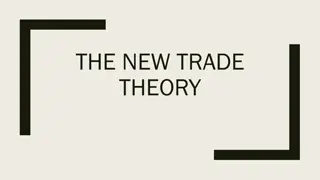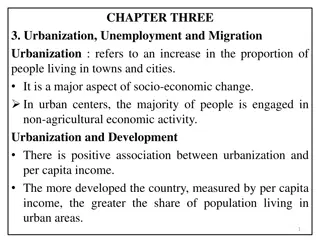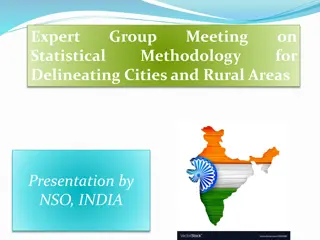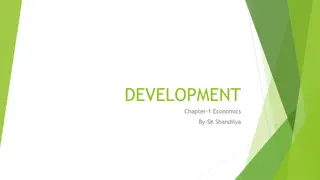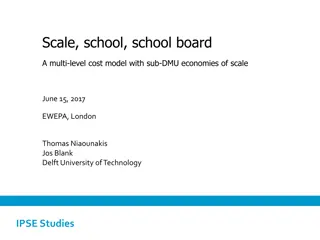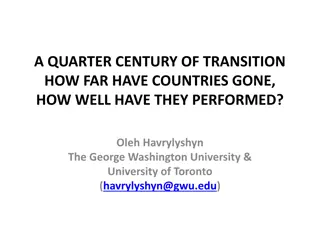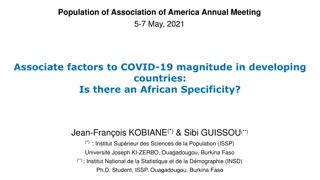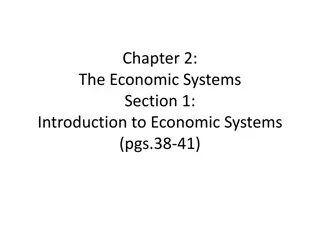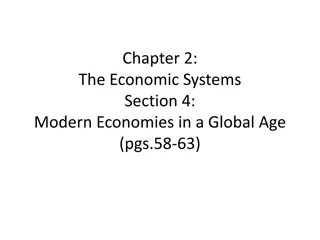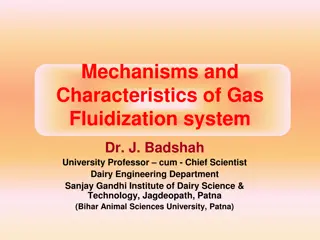Agglomeration Economies in Developing Countries: Analysis and Implications
The study delves into the benefits of agglomeration economies in developing nations with a focus on urbanization and informal economies. The research addresses challenges in defining urban areas without commuting data and analyzes the impact on productivity and wages. References to related works are included.
Download Presentation

Please find below an Image/Link to download the presentation.
The content on the website is provided AS IS for your information and personal use only. It may not be sold, licensed, or shared on other websites without obtaining consent from the author.If you encounter any issues during the download, it is possible that the publisher has removed the file from their server.
You are allowed to download the files provided on this website for personal or commercial use, subject to the condition that they are used lawfully. All files are the property of their respective owners.
The content on the website is provided AS IS for your information and personal use only. It may not be sold, licensed, or shared on other websites without obtaining consent from the author.
E N D
Presentation Transcript
Agglomeration economies in developing countries JDS International Seminar Tsukuba January 24th2019 Vicente Royuela E-mail: vroyuela@ub.edu AQR-IREA Research Group, University of Barcelona (Spain)
Agglomeration economies in developing countries. The analysis of the benefits of agglomeration economies have been object of a wide range of studies, showing positive impacts of spatial externalities on productivity and wages (Combes, 2000; Combes et al., 2008; Mion and Naticchioni, 2009) The growth of the world urban rate is being driven by urbanization in the developing world. Still, few studies have looked at the importance of agglomeration economies in the developing countries, being economies: China, India, Brazil or Colombia (Chauvin et al., 2017; Duranton, 2016 and Combes et al., 2015) all in large and emerging 2 / 129
Agglomeration economies in developing countries. Developing countries are generally characterized by a lack of data, what has slowed the applied study of these areas. A parallel and connected aspect is the presence of the informal economy (Fields, 1990; La Porta and Shleifer, 2014), an aspect hard to analyze again due to data availability. 3 / 129
Agglomeration economies in developing countries. In this presentation I plan to show how we have addressed the investigation of a research in a small developing economy such as Ecuador. I present two linked papers which in the end each of them has an independent value added. First I present the definition of urban areas in developing countries when the researcher has no chance to use commuting data. And Second, once we have defined economic cities, we analyse agglomeration economies in Ecuador considering the role of informality. 4 /129
Agglomeration economies in developing countries. The work presented here is shared with Mois s Obaco, V tores Xavier and Alessia Matano. Of course, any error of this presentation is my fault. References of available works: - Obaco, M., Royuela, V. and Xavier, V. (2019) Identifying Functional Urban Areas in Ecuador Using a Varying Travel TimeApproach , Geographical Analysis, forthcoming. - Matano, A., Obaco, M. and Royuela, V. (2018) What drives the spatial wage premium for formal and informal workers? The case of Ecuador , AQR-IREA Working paper 2018/6. (available at http://www.ub.edu/aqr) 5 /129
Using the right definition of an economic phenomenon is the best way to analyse problems and find solutions prom a policy perspective.
Administrative boundaries Economic boundaries At the city level the administrative unit. unit of analysis is usually the Still, real rather than administrative city should be used to collect information, develop public policies etc. This work is about that: how to define metropolitan areas. Different methods have been used to look at the economic definitions of space: SMA, LLMA (TTWA), FUA, FUR, Regionalization, etc
Administrative boundaries Economic boundaries Klapka et al., (2014), Hal s et al., (2015): -There is not a consensus of the best approach, - Different approaches give different results and -The same approach can give sharply different results when using different threshold values The OECD together with the European Commission developed a new and coordinated definition of a city and its commuting zone, under the label of Functional Urban Areas (FUAs)
OECD Methodology: 3 steps 1. Identifying urban cores: Grid cells of high inhab./km2). Minimum size (50,000 100,000 inhab. to be an urban core) Municipality of reference (at least 50% of population) population density (1,000 1,500
OECD Methodology: 3 steps 2. Connecting non-contiguous urban cores that belong to the same FUA: among areas of reference of urban cores (at least 15% of commuting flow).
OECD Methodology: 3 steps 3. The hinterland: areas surrounding urban cores but not dense enough to be cores, but that in fact are connected with them (at least 15% of commuting flow)
What is the problem.? Commuting data
What do we do? Generic proposal: identification of FUAs by using accessibility as a proxy of actual flows by means of the use of GIS data and travel time
Our proposal 1. Identifying Urban Cores: High density grid cells in 1 km2 Cluster of high population density (Extra rules) Minimum size of self-containment 2. Connecting non-contiguous Urban Cores: We consider a varying threshold by city size: ? ? ? ?? ?= ? ?1 ? ?? ???1(Ahlfeldt & Wendland, 2015) 3. Defining hinterland: Again, we consider a threshold varying by the size of the urban core ???? ?= ??2 ? ?? ???2
What do we do? Specific aim: identify FUAs in Ecuador such that we can develop economic analysis. For that purpose we aim at maximizing the number of FUAs We follow the spirit of OECD methodology while adapting the thresholds to our case study and purpose.
Application Ecuador Small Open Developing Economy Not important transportation system other than roads Close to the world average in terms of population size and geographical characteristics
Application DATA: 1st step) LandScan 2013 database used OECD (Raster data of 1 km2in SHP) QGIS 2nd step) Google map service (Stratification Algorithm, road information) STATA 3rdstep) Open Street Map (Isochrones-road information) QGIS Administrative level: INEC (Municipalities)
Application Setting the minimum thresholds MINIMUM THRESHOLD FOR URBAN CORES: Lower values applied in developed economies as starting point 500 inh/km2 and 25,000 inh. urban core 3% of total grids cells
1ststep) N Cells Pop Mean Median Max Min S.D. 1 310 2553993 8238.69 5008.5 39800 0 9150.31 2 523 2166700 4142.83 1753 41536 3 4950.62 Total 34 urban cores 3 97 347371 3581.14 1770 39473 92 4809.74 4 80 294618 3682.73 1910.5 21696 11 4337.59 5 32 286186 8943.31 5531 31110 58 9217.87 6 123 276507 2248.02 729 19390 7 3589.86 7 41 250088 6099.71 4272 43145 91 8935.1 8 49 212192 4330.45 1891 35823 112 7233.95 9 42 180342 4293.86 1318 36652 392 7853.18 10 37 174433 4714.41 1849 19467 28 5388
2ndstep) FIXED TRAVEL TIME THRESHOLD: SHLC 2014; 1 hour by public transport (60%) 30 minutes by private car Speed=45 km/h
2ndstep) CALIBRATION USING COLOMBIAN DATA: CONNECTING URBAN CORES (POLICENTRICITY). Travel time threshold depends on the size of the urban core: the larger the core the further the connectivity ? ? ? ?? ?= 13 ? ?? ?1 4
3rdstep) CALIBRATION USING COLOMBIAN DATA: HINTERLANDS Defining the area of influence of the urban cores BARRANQUILLA BOGOT MEDELL N
3rdstep) CALIBRATION USING COLOMBIAN DATA: HINTERLANDS Relationship between size of the urban core and size of the hinterland
3rdstep) CALIBRATION USING COLOMBIAN DATA: HINTERLANDS Relationship between size of the urban core and size of the hinterland (1) (2) (3) VARIABLES ln(areai) ln(timeh) 0.334*** (0.0862) ln(areah) 0.459*** (0.114) ln(ltimeh) 0.501*** (0.133) -0.462 (0.888) 19 0.453 ln(areah) 1.498*** (0.364) 19 0.469 4.752*** (0.480) 19 0.490 Constant Observations R-squared Standard errors in parentheses *** p<0.01, ** p<0.05, *p<0.1 ???? ?= 4.5 ????1/3.
Results for Colombia Min Pop Urban cores used Link Total Pop Total FUAs St. Desv. Mean Median Min Max Commuting based approach 25 50 100 35 25 50 100 35 Accessibility based approach 25 88 50 64 100 35 25 88 50 64 100 35 88 64 76 57 34 80 58 34 27,493 26,791 25,237 27,195 26,374 24,741 361 470 742 339 454 721 83 121 322 82 116 328 25 50 101 25 50 100 7,606 7,606 7,606 7,539 7,539 7,539 995 1,131 1,407 954 1,099 1,372 Commuting at least10% 88 64 Commuting at least15% Fixed travel time Varying Travel time 69 54 32 76 56 34 27,214 26,211 24,642 27,253 26,390 24,709 494 569 794 363 471 726 149 190 354 90 121 298 25 50 100 25 50 100 7,636 7,654 7,608 7,597 7,703 8,674 1,156 1,237 1,449 1,008 1,229 1,410
Sensitivity analysis for Ecuador Results: # FUAs Fixed travel time (in minutes) Initial Number of Urban Cores Varying traveltime Minimum Size Threshold 25,000 50,000 100,000 25,000 50,000 100,000 25,000 50,000 100,000 Density threshold (in Gridcells 30m 60m 90m minutes) 3,699 (3%) 34 21 16 29 20 16 33 21 16 28 20 15 27 20 15 29 20 14 30 20 15 28 20 15 31 20 15 23 16 13 22 16 13 22 16 13 16 14 12 15 14 12 15 14 12 500 inh./km2 1,000 inh./km2 2,114 (1.75%) 1,500 inh./km2 1,532 (1.25%)
Robustness checks for Ecuador - Commuting patterns: Survey HLC 2014 50,000 workers; 6,800 commuters; 2,800 pairs of parishes -Gravity equation: Rescale SHLC & National Census of Population 2010. ??????????,??= ? ?1? ?? ?? ?2? ?? ??? ? ?3? ? - Radiation model*: National Census of population 2010. ??????? ? ??????? ? ??? ? ? ? = ? ?? ? ??????? ?+ ????,??) (??????? ?+ ??????? ?+????,?? -Internal migration: National Census of population 2010. (2005-2010; geographical restrictions)
Robustness checks Population inFU (% ofTotal) (7) FUAs (1) Min (2) Max (3) Mean (4) Median (5) St. Dev. (6) Accessibility (varying Traveltime) 10,004,967 (63.80%) 28 37,663 2,812,609 357,320 172,578 663,008 Commuting SHLC (10%) Commuting Gravitational (10%) 10,222,899 (65.15%) 31 53,237 2,930,848 340,763 150,258 658,285 9,739,748 (62.07%) 33 37,663 2,769,539 295,143 107,129 618,271 Commuting Radiation (10%) Migration flows (15%) 9,481,786 (60.05%) 11,260,940 (71.77%) 32 33,186 2,492,869 296,305 161,022 572,811 29 59,312 2,558,798 417,070 280,325 634,405
Conclusions first part Using GIS, we have enough available information to approximate integrated cities Accessibility using travel time by road seems a good proxy to socio economic flows (commuting) There is not a consensus among the best minimum threshold to work in developing countries. Still, lower thresholds fit better in developing countries. At very high thresholds results are robust to different techniques. However, it might make invisible urban cores that can be important (e.g. less dense regions). The hinterland seems to be the most sensible and difficult to define.
Agglomeration economies Once we have identified urban areas, we aim at analyzing the importance of agglomeration economies for Ecuador and to check the importance of the informal sector within the productivity city size relationship. Ecuador has: - an average geographical extension and population size, - a relatively low and increasing urbanization rate, - a modest industrial activity, - a wide presence of informal employment.
Agglomeration economies Agglomeration economies Marshall (1890) pointed out the productivity gains that may arise in bigger cities or from the concentration of a specific industry in a given location. Three channels are identified (Duranton and Puga, 2004): - the learning mechanism: knowledge spillovers and face-to- face interactions that enhance human capital; - the matching mechanism: agglomerated areas allow for achieving a better match between workers and firms; - the sharing mechanism: the advantages generated by sharing indivisible goods such as facilities and even risks, which decrease individuals and firms costs,
Agglomeration economies Previous empirical findings Using aggregate data: Glaeser et al., 1992; Ciccone and Hall, 1996; Ciccone, 2002; Combes, 2000 Using individual (worker or firm) data: Combes et al., 2008, Combes et al., 2010, Mion and Naticchioni, 2009, De la Roca and Puga, 2017 Identification problems - endogeneity: treated by using an IV strategy - sorting of skilled workers: addressed by means of individual level panel data
Agglomeration economies Previous empirical findings In developing countries: cross-sectional individual level data with a large set of controls + IV estimates. Chauvin et al. (2017): High elasticities for China and India (8- 9%) and lower for Brazil and US (5%) Combes et al. (2015): China (11-14%) Duranton (2016): Colombia (5%) Ahrend et al. (2015): Mexico (4%)
Agglomeration economies Previous empirical findings Informality in the labour market: not addressed in most cases, although it represents a large share of the workforce (50%). Usually composed of low-educated workers, with a high level of vulnerability and poverty, low wages and productivity, and lack of legal protection. (La Porta and Shleifer, 2014, Khamis, 2012, Overman and Venables, 2005, Maloney, 2004, Fields, 1990) A proper analysis of the relevance of spatial externalities in a developing economy should take into account informality (Glaeser and Henderson, 2017).
Agglomeration economies Few previous analysis: Colombia: Garcia (2016) and Duranton (2016). Per : Bernedo Del Caprio and Patrick (2017) Kenia: Harris (2014)
Agglomeration economies Empirical approach We use data from the Ecuadorean Labor Surveys (ENEMDU): repeated cross-section quarterly surveys (2007 to 2017), containing detailed information on Ecuadorean workers: - labor income, - worked hours, - age, - gender, - ethnicity, - education, - occupation, - previous migrant status - and informal employment status
Agglomeration economies Empirical approach We have also information on: - workers area/city of residence - and sector of employment. Instruments: we use - population census of 1950 and 1990 - city PH soil Spatial units of analysis: FUAs
Agglomeration economies Empirical approach Sample restricted to workers located in the FUAs areas (males and females) aged between 15 and 64 years old, who perform one job. Sample cleaned of 1% top and bottom of: - workers real wage distribution, - worked hours, - and real wages per worked hour. We end up with a sample of 383,435 observations for the period of analysis, around 9,500 per quarter.
Agglomeration economies Empirical approach Informality: defined according to the last methodology implemented by the INEC (following the 2013 ILO guidelines): informal workers as those employed in firms with less than 100 employees with no tax identification number (Registro unico del contribuyente, RUC)
Agglomeration economies Empirical approach We use two measures of agglomeration effects: - Total FUAs population, proxying urbanization externalities capturing the effect of urban scale on wages - Sectoral specialization at the local level. We compute it as in Mion and Naticchioni (2009), Combes (2000) and Matano and Naticchioni (2012): ????????? ? , ? ? , ? ? ???????? ? ? ? ? ? ? ? ? ? ? ,? ? ,? ?= ? ? ??? ? ? ?? ? ,? ? ? ? ??? ? ? ? ? ? ,? ? ? ?
Agglomeration economies Table C1: Descriptive Statistics. Real Wage per Hour and Sample Composition by Worker Categories Sample Composition % 100 Mean Real Wage per Hour (US dollars) Worker data Total Gender Male Female Ethnicity Indigenous White Mestizo* Black Mulatos** Education level At Most Literacy School HighSchool Technical University Post-Univ.Degree 2007 2.20 2012 2.30 2017 2.61 All 2.37 2.24 2.14 2.39 2.14 2.69 2.49 2.45 2.24 61.76 38.24 1.68 2.53 2.22 1.64 1.72 1.89 2.93 2.31 1.99 1.94 1.89 3.17 2.66 2.24 2.10 1.80 2.64 2.41 2.03 2.00 4.38 3.25 88.60 2.44 1.33 1.41 1.62 2.00 2.63 3.23 5.65 1.63 1.84 2.13 2.59 3.07 4.77 1.73 2.00 2.37 3.03 3.62 6.12 1.47 1.81 2.18 2.91 3.32 5.71 0.28 30.45 43.70 1.42 23.24 0.91
Agglomeration economies Job Category (1) Dependent workers Self-employed Job Category (2) Formal Sector Workers Informal Sector Workers Economic Sector Agriculture, Fishing Mining andQuarrying Manufacturing Electricity, Gas and WaterSupply Construction Wholesale and RetailTrade Hotels and Restaurants Transport, Storage andCommunications Financial Intermediation Real Estate, Renting and Business Activities Private Education, Health andSocial Work Other Service Activities Region Andean 2.13 2.31 2.38 2.19 2.80 2.38 2.49 2.22 56.83 43.17 2.54 1.71 2.62 1.72 3.04 1.84 2.76 1.70 63.09 36.91 1.72 3.84 2.15 3.60 2.08 2.11 2.13 2.22 3.73 2.63 2.82 1.97 1.91 3.78 2.27 2.90 2.24 2.18 2.25 2.35 3.63 2.68 2.90 1.95 2.03 4.28 2.62 3.00 2.43 2.48 2.43 2.51 4.56 3.01 3.65 2.49 1.88 4.19 2.34 3.13 2.28 2.25 2.26 2.36 3.95 2.80 3.18 2.12 8.58 0.57 16.76 0.18 9.04 29.14 7.29 9.79 1.62 6.94 5.51 4.59 2.38 2.35 2.80 2.53 53.66 Coastal Amazonian Area Urban Rural 1.99 2.22 2.23 2.47 2.37 2.36 2.15 2.47 41.96 4.39 2.24 1.62 2.35 1.82 2.68 2.03 2.43 1.88 89.83 10.17
Agglomeration economies Regressions Log(????,??) = ? ?+ ??log(??????? ???,??) + ??l o g( ??????? ?? ???,????,??)+ +X??,?? + A??(??) +Ss i + R??(??) + T??+ ??,?? Controls: Ss i Worker s characteristics (X??,??) : age, age squared, female dummy, migrant dummy, ethnicity, education. Rural / urban A??(??) Sector dummies Ss i Natural regions of Ecuador R??(??) Period dummies T??
Agglomeration economies Regressions Log(????,??) = ? ?+ ??log(??????? ???,??) + ??l o g( ??????? ?? ???,????,??)+ +X??,?? + A??(??) +Ss i + R??(??) + T??+ ??,?? Instruments: Ss i Historical population in 1950 The degree of specialization in 1990 Soil PH as extra instrument to check for the validity of our instruments (overidentification tests)
Table 1: OLS and IV regressions of wages on the spatial variables. Dependent variable: log of real worker's wage per hour. (1) (2) (3) (4) (5) OLS 0.059*** (0.012) 0.015 (0.022) OLS 0.036*** (0.009) 0.023*** (0.010) -0.167*** (0.008) 0.037*** (0.011) -3.95e-04*** (1.43e-05) 0.033*** (0.001) 0.041*** (0.007) -0.058*** (0.001) yes yes yes yes yes yes 383,435 0.29 IV IV IV Log(Pop) 0.035*** (0.009) 0.017 (0.012) -0.167*** (0.008) 0.037*** (0.011) -3.95e-04*** (1.43e-05) 0.033*** (0.001) 0.041*** (0.007) -0.058*** (0.001) yes yes yes yes yes yes 383,435 0.29 148.30 0.035*** (0.009) 0.017 (0.012) -0.167*** (0.008) 0.037*** (0.011) -3.95e-04*** (1.43e-05) 0.033*** (0.001) 0.041*** (0.007) -0.058*** (0.001) yes yes yes yes yes yes 383,435 0.29 108.10 0.555 0.083*** (0.022) 0.009 (0.016) -0.180*** (0.006) 0.039*** (0.011) -4.15e-04*** (1.33e-05) 0.032*** (0.001) 0.036*** (0.008) -0.064*** (0.001) yes yes yes yes yes yes 263,778 0.27 10.43 0.347 Log(Specialization) Female dummy Age Age squared Education Migrant dummy Rural dummy Ethnicity dummies Job categorydummies Occupation dummies Sector dummies Region dummies Time dummies Observations R-squared Weak identification test(F-value) Over identification test (p-value) no no no yes yes yes 383,435 0.12
